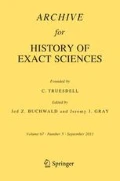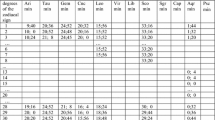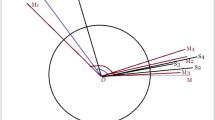Abstract
Late Babylonian astronomical texts contain records of the stationary points of the outer planets using three different notational formats: Type S where the position is given relative to a Normal Star and whether it is an eastern or western station is noted, Type I which is similar to Type S except that the Normal Star is replaced by a reference to a zodiacal sign, and Type Z the position is given by reference to a zodiacal sign, but no indication of whether the station is an eastern or western station is included. In these records, the date of the station is sometimes preceded by the terms in and/or EN. We have created a database of station records in order to determine whether there was any pattern in the use of these notation types over time or an association with any bias in the station date or the type of text the station was recorded in. Predictive texts, which include Almanacs and Normal Star Almanacs, almost always use Type Z notation, while the Diaries, compilations, and Goal-Year Texts use all three types. Type Z records almost never include in or EN, while other types seem to include these interchangeably. When compared with modern computed station dates, the records show bias toward earlier dates, suggesting that the Babylonians were observing dates when the planets appeared to stop moving rather than the true station. Overlapping reports, where a station on the same date was recorded in two or more texts, suggest that predicted station dates were used to guide observations, and that the planet’s position on the predicted stationary date was the true point of the observation rather than the specific date of the stationary point.








Similar content being viewed by others
Data availability
The database of planetary stations compiled during this research may be downloaded from https://repository.library.brown.edu/studio/item/bdr:1155513/
References
Al-Rawi, F.N., and N.A. Roughton. 2003. IM 44152: A Jupiter Observational Tablet from Uruk. Archiv für Orientforschung 50: 340–344.
Britton, J.P. 1998. Planetary Theory in Babylon (Essay review of N. M. Swerdlow, The Babylonian Theory of the Planets). Journal for the History of Astronomy 29: 381–385.
Britton, J. P. 2004. “An Early Observational Text for Mars: HSM 1899.2.112 (=HSM 1490)”. In Studies in the History of the Exact Sciences in Honour of David Pingree, ed. C. Burnett, J. P. Hogendijk, K. Plofker & M. Yano, 33–55. Leiden: Brill.
de Jong, T. 2019. A Study of Babylonian Planetary Theory I. The Outer Planets. Archive for History of Exact Sciences 73: 1–37.
Gray, J.M.K., and J.M. Steele. 2008. Studies on Babylonian Goal-Year Astronomy I: A Comparison Between Planetary Data in Goal-Year Texts, Almanacs and Normal Star Almanacs. Archive for History of Exact Sciences 62: 553–600.
Haubold, J., J.M. Steele, and K. Stevens. 2019. Introduction. In Keeping Watch in Babylon: The Astronomical Diaries in Context, ed. J. Haubold, J.M. Steele, and K. Stevens, 1–18. Brill: Leiden.
Huber, P.J. 1977. Early Cuneiform Evidence for the Existence of the Planet Venus. In Scientists Confront Velikovsky, ed. D. Goldsmoth, 117–144. Ithica and London: Cornell University Press.
Hunger, H. Forthcoming 2006. Astronomical Diaries and Related Texts from Babylonia. Volume IV: Undated Diaries. Vienna: Österreichishe Akademie der Wissenschaften.
Hunger, H. 1999. Non-Mathematical Astronomical Texts and Their Relationships. In Ancient Astronomy and Celestial Divination, ed. N.M. Swerdlow, 77–96. Cambridge, MA: The MIT Press.
Hunger, H. 2000. Saturnbeobachtungen aus der Zeit Nebukadnezars II. In Assyriologica et Semitica: Festshrift für Joachim Oelsner anläßlich seines 65. Geburtstages am 18. February 1997, ed. J. Marzahn, H. Neumann and A. Fuchs, 189–192. Münster: Ugarit-Verlag.
Hunger, H. 2001. Astronomical Diaries and Related Texts from Babylonia. Volume V: Lunar and Planetary Texts. Vienna: Österreichishe Akademie der Wissenschaften.
Hunger, H. 2006. Astronomical Diaries and Related Texts from Babylonia. Volume VI: Goal Year Texts. Vienna: Österreichishe Akademie der Wissenschaften.
Hunger, H. 2014. Astronomical Diaries and Related Texts from Babylonia. Volume VII: Almanacs and Normal Star Almanacs. Vienna: Österreichishe Akademie der Wissenschaften.
Hunger, H. 2015. A Collection of Observations from the Reign of Artaxerxes I. SCIAMVS 15: 35–51.
Jones, A. 2004. A Study of Babylonian Observations of Planets Near Normal Stars. Archive for History of Exact Sciences 58: 475–536.
Mitsuma, Y. 2015. From Preliminary Diaries to Short Diaries: The First and Second Steps in the Compilation Process of the Late Babylonian Astronomical Diaries. SCIAMVS 16: 53–75.
Ossendrijver, M. 2012. Babylonian Mathematical Astronomy: Procedure Texts. New York: Springer.
Parker, R. A. and W. H. Dubberstein. 1956. Babylonian Chronology 626 B.C. – A.D. 75. Providence: Brown University Press.
Rochberg, F. 2016. Before Nature: Cuneiform Knowledge and the History of Science. Chicago: University of Chicago Press.
Roughton, N.A. 2002. A Study of Babylonian Normal-Star Almanacs and Observational Texts. In Under One Sky: Astronomy and Mathematics in the Ancient Near East, ed. J.M. Steele and A. Imhausen, 367–378. Münster: Ugarit-Verlag.
Ruggles, C.L.N. 1997. Whose Equinox? Journal for the History of Astronomy, Archaeoastronomy Supplement 22: S45–S50.
Sachs, A. J. and H. Hunger. 1988. Astronomical Diaries and Related Texts from Babylonia. Volume I: Diaries from 652 B.C. to 262 B.C. Vienna: Österreichishe Akademie der Wissenschaften.
Sachs, A. J. and H. Hunger. 1989. Astronomical Diaries and Related Texts from Babylonia. Volume II: Diaries from 261 B.C. to 165 B.C. Vienna: Österreichishe Akademie der Wissenschaften.
Sachs, A. J. and H. Hunger. 1996. Astronomical Diaries and Related Texts from Babylonia. Volume III: Diaries from 164 B.C. to 61 B.C. Vienna: Österreichishe Akademie der Wissenschaften.
Steele, J.M. 2003. Planetary Latitudes in Babylonian Mathematical Astronomy. Journal for the History of Astronomy 34: 269–289.
Steele, J.M. 2011. Goal-Year Periods and Their Use in Predicting Planetary Phenomena. In The Empirical Dimension of Ancient Near Eastern Studies – Die empirische Dimension altorientalischer Forschungen, ed. G. Selz and K. Wagensonner, 101–110. Wien: LIT Verlag.
Steele, J.M. 2017. A Text Containing Observations of Mars from the time of Nebuchadnezzar II. In Studies on the Ancient Exact Sciences in Honor of Lis Brack-Bernsen, ed. J.M. Steele and M. Ossendrijver, 67–78. Berlin: Edition Topoi.
Steele, J.M. 2019. An Early Compilation of Saturn Observations from Babylon. Journal for the History of Astronomy 50: 31–45.
Steele, J.M., and J.M.K. Gray. 2007. A Study of Babylonian Observations Involving the Zodiac. Journal for the History of Astronomy 38: 443–458.
Swerdlow, N.M. 1998. The Babylonian Theory of the Planets. Princeton: Princeton University Press.
Acknowledgements
We thank Hermann Hunger for generously sharing with us his editions of additional dated Astronomical Diaries in advance of their publication in Hunger (forthcoming), and the late Norbert Roughton for providing a copy of his tables of computed planetary phenomena.
Author information
Authors and Affiliations
Corresponding author
Ethics declarations
Conflict of interest
On behalf of all authors, the corresponding author states that there is no conflict of interest.
Additional information
Communicated by Alexander Jones.
Rights and permissions
About this article
Cite this article
Steele, J.M., Meszaros, E.L. A study of Babylonian records of planetary stations. Arch. Hist. Exact Sci. 75, 415–438 (2021). https://doi.org/10.1007/s00407-021-00272-5
Received:
Accepted:
Published:
Issue Date:
DOI: https://doi.org/10.1007/s00407-021-00272-5




